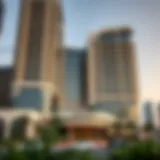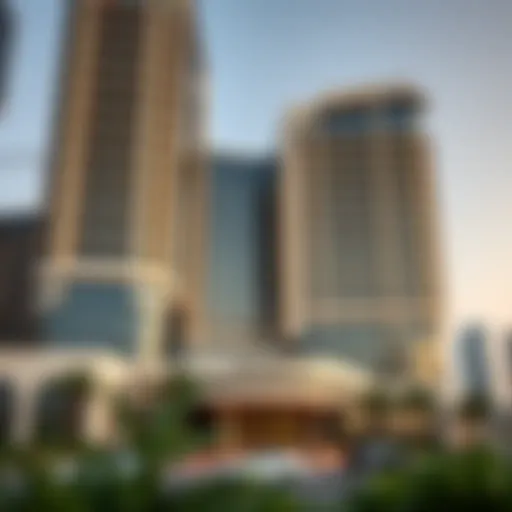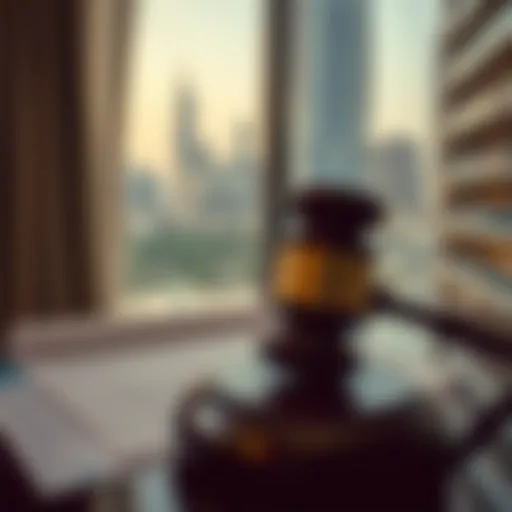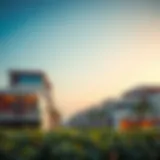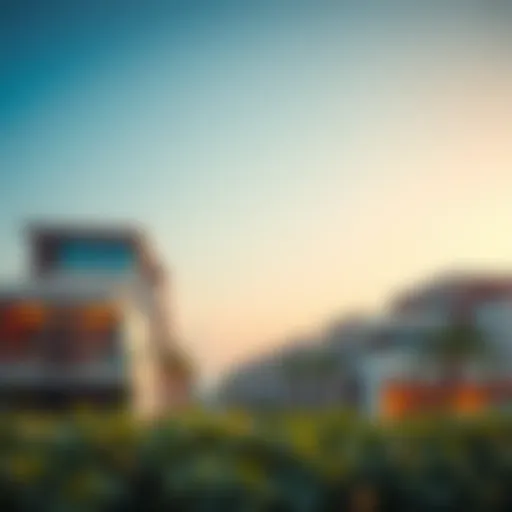Jaddaf Metro Station: A Hub of Urban Growth in Dubai


Intro
Jaddaf Metro Station has emerged as a pivotal point in Dubai’s ambitious urban development strategy. Nestled within the dynamic landscape of the emirate, this facility serves not just as a transit point but as a linchpin anchoring various urban developments. In a city where innovation and progress shape daily life, understanding Jaddaf Metro Station offers a lens into Dubai’s future. The success of this station reflects the city's commitment to enhancing public transport and supporting expanding urban areas.
In this exploration, we will unravel the architectural marvel that is Jaddaf Metro Station, investigate its role in promoting urban mobility, and analyze how it drives real estate trends in its vicinity. Through a detailed look at market trends, property listings, and ongoing developments, we will provide valuable insights for investors, realtors, homebuyers, and developers alike.
As Dubai continues to evolve, so too does the significance of strategic transport hubs like Jaddaf Metro Station. This examination seeks to highlight the interconnectedness of urban design, transport infrastructure, and real estate opportunities, revealing how they collectively elevate the city's living experience.
Market Trends and Insights
Current Market Analysis
The area surrounding Jaddaf Metro Station has seen a notable increase in real estate investment, sparked by heightened connectivity and infrastructural improvements. Investors have begun to keenly observe how the station facilitates easier access to various districts within Dubai. As such, properties that offer proximity to the metro line are in high demand.
Jaddaf is evolving into a desirable area characterized by a mix of residential units, commercial establishments, and leisure facilities. Just around the corner, a combination of premium amenities and essential services provide residents with both convenience and sophistication.
Historical Trends and Future Predictions
Historically, areas benefiting from metro accessibility in Dubai have experienced rapid growth. For instance, the establishment of the Burj Khalifa Metro Station catalyzed development in that precinct, leading to a surge in residential sales and rentals. Similarly, the trends seen around Jaddaf are expected to mirror this pattern.
Looking ahead, projections indicate that as more developments materialize in the vicinity of Jaddaf Metro Station, property values could steadily rise. A report from Dubai Land Department suggests that by 2025, property investments in Jaddaf could yield high returns as urban renewal projects come to fruition.
"Investors should keep an eye on Jaddaf; the area is poised for substantial growth given the ongoing infrastructure projects and its strategic location."
To monitor current trends more effectively, potential investors can benefit from staying connected with localized research platforms and analytical tools that offer insights into emerging patterns and market dynamics.
Property Listings and Comparisons
Luxury Properties Overview
For those looking to dabble in high-end real estate near Jaddaf Metro Station, several luxury developments have been launched recently. These properties often feature modern designs, state-of-the-art facilities, and proximity to lifestyle attractions. Some noteworthy developments include the upscale apartments in Dubai Creek Harbour, providing stunning water views and spacious environments, tailored for the discerning homebuyer.
Affordable Housing Options
While luxury options are plentiful, not all properties near Jaddaf come with steep price tags. There are affordable housing developments designed to attract a diverse demographic. Projects like the ones in Al Jaddaf are affordable alternatives without compromising on quality or location. These offerings aim to provide first-time buyers and families with a foothold in a thriving urban zone.
As investments near Jaddaf Metro Station continue to grow both in luxury and affordable segments, it underscores the potential for diverse living experiences catering to various budgets and lifestyles, further fostering community integration.
Each step taken toward enhancing Jaddaf as a transport hub not only connects people but invigorates the entire sector surrounding it.
Prologue to Jaddaf Metro Station
Jaddaf Metro Station serves as a significant junction within Dubai's ever-expanding transport network. Anchoring the city's public transit system, it’s not merely a stop on the Red Line; it represents a critical node in the larger scheme of urban connectivity. The importance of this station extends beyond just its operational capabilities; it enhances accessibility, shapes local real estate developments, and nods to the city’s ambitious ambitions for the future.
Overview of the Metro Network in Dubai
Dubai’s metro network stands out as one of the most progressive and expansive in the region. Initially launched in 2009, the metro comprises two primary lines—the Red Line and the Green Line—catering to millions of commuters each month. As of now, with over 75 kilometers of track and numerous stations, the metro is instrumental in easing road congestion, minimizing travel times, and promoting sustainable urban travel.
Jaddaf Metro Station plays a pivotal role in this framework, connecting neighborhoods and commercial districts, while also linking to other essential transit systems such as buses and water taxis. This multifaceted transportation system has led to an uptick in ridership, further corroborating the emphasis on public transport as a viable alternative in a sprawling urban landscape.
Historical Context of Jaddaf Metro Station
Jaddaf Metro Station opened its doors in 2011, during a time when Dubai was experiencing unprecedented growth and transformation. Its location was carefully chosen to enhance accessibility to nearby residential areas, hospitals, and cultural venues. It’s a testament to Dubai’s strategic planning pursuits, reflecting the emirate’s commitment to developing infrastructure that meets both current and future demands.


At this juncture, Jaddaf transformed from a primarily commercial and residential zone into a pivotal transit point that supports the dynamic lifestyle of its inhabitants. With ongoing urban developments and projects, the station is a crucial element in Dubai’s intricate urban fabric. Its establishment has not only made daily commutes easier but has also sparked a surge in surrounding area developments, altering the socio-economic landscape of the Jaddaf district.
"The Jaddaf Metro Station is more than just a transit stop; it’s a cornerstone of Dubai’s urban evolution."
This historical context also underlines the broader trends within Dubai’s infrastructural development. It's important to consider how Jaddaf's positioning is part of a larger narrative about urban growth, sustainability, and the push toward a more connected and efficient city. The station embodies the region's response to the challenges of rapid urbanization, providing residents and visitors alike with essential access points that foster a cohesive living environment.
Through this examination of Jaddaf Metro Station, we can begin to appreciate not only its practical utility but also its influence on shaping urban mobility and development across the city.
Architectural Design and Features
The architectural design of Jaddaf Metro Station holds significant importance as it serves not only as a functional transport hub, but also an aesthetic landmark in Dubai. This station is a vital part of the city’s metro network, facilitating commuter flow while also beautifying the urban landscape. By examining the elements that make Jaddaf Metro Station unique, we can appreciate its role in enhancing the connectivity and overall aesthetic of the area.
Modern Aesthetics of Jaddaf Station
Jaddaf Metro Station showcases contemporary design that resonates with Dubai's commitment to modern urbanism. The structure blends seamlessly with the city’s skyline, marked by sleek lines and innovative materials. The glass façade allows natural light to flood the interior, fostering an open and inviting atmosphere. This use of light in the design not only serves the visual appeal but also promotes energy efficiency—an aspect that aligns with modern architectural trends.
Visitors and commuters walk through spaces that are not just transit areas but experiential zones. Features like well-thought-out seating arrangements, distinct landmark signage, and art installations created by local artists elevate the user experience. The harmonious integration of form and function is evidenced in how the station caters to varied users, from daily commuters to tourists curious about Dubai’s public transport system.
The distinct architecture stands as a testament to Dubai's innovative spirit. As a prime example of modern aesthetics, Jaddaf Metro Station emphasizes functionality without sacrificing style, which can greatly appeal to investors and urban developers looking to understand effective design principles in rapidly growing cities.
Sustainability Initiatives in Design
Sustainability plays a pivotal role in the design philosophy of Jaddaf Metro Station. Understanding that urban spaces have a significant environmental impact, the developers have incorporated several sustainable practices. Energy-efficient systems are at the core of this initiative. For instance, solar panels installed at strategic points aid in reducing dependence on non-renewable energy sources.
Moreover, the station features rainwater harvesting systems, which collect and recycle water for irrigation and cleaning purposes. This dual-purpose system not only conserves water but also mitigates the risk of flooding during heavy rains—a reality for many urban areas.
The materials used in construction are selected for their low environmental impact. Over 20% of them are recycled materials, significantly lowering the carbon footprint of the project. Additionally, occupying a prime location encourages behavior aimed at reducing reliance on private vehicles, further pushing the agenda for sustainable urban mobility.
"The Jaddaf Metro Station serves as more than just a transport hub; it symbolizes a commitment to sustainable and modern living in urban centers."
In summary, the architectural design and sustainability initiatives at Jaddaf Metro Station exhibit a forward-thinking approach that makes it an exemplar in urban development. Investors, homeowners, and developers alike can glean insights into how aesthetic considerations, combined with sustainable practices, can lead to successful projects in bustling cities.
Operational Aspects of Jaddaf Metro Station
Understanding the operational aspects of Jaddaf Metro Station offers a glimpse into not just its functionality, but also how it affects the economic and social landscape surrounding it. As one of the integral parts of Dubai's metro system, the station is designed to cater to a dynamic urban population, needs, and growth. The station serves as a linchpin, facilitating the seamless movement of residents, visitors, and professionals, significantly enhancing the overall urban mobility in Dubai.
Daily Operations and Service Frequency
Every day, Jaddaf Metro Station buzzes with the activity of commuters, showcasing its role as a reliable hub in the metro network. The service frequency is meticulously planned. Typically, trains arrive every few minutes during peak hours, while the intervals may lengthen somewhat during off-peak times. This efficiency in daily operations is pivotal for maintaining a steady flow of riders who depend on the metro for their daily commute.
In fact, the average daily ridership often exceeds tens of thousands, which illustrates the station's popularity. Such figures indicate not just the operational success but also hint at broader socio-economic trends. When a metro station draws in more passengers, it usually correlates with nearby real estate developments, further pushing urban growth in that area.
Integration with Other Transport Modes
Another significant part of Jaddaf Metro Station's operational philosophy is its integration with various modes of transport. It provides convenient access to buses and taxis, allowing for easy transitions for passengers. This multimodal approach is essential; it ensures that commuters can shift from one type of transportation to another without any hassle.
This interconnectedness promotes not only the usage of public transport but also mitigates traffic congestion in the surrounding areas. Riders can efficiently navigate through Dubaï's vast urban tapestry, connecting their journeys to places like Dubai International Airport or the bustling downtown areas without breaking a sweat. It is this kind of convenience that elevates the metro system from just a means of transport to a comprehensive urban mobility solution.
Additionally, platforms like the RTA (Road and Transport Authority) provide real-time updates on service disruptions, ensuring that commuters are always informed. It creates an atmosphere of trust and reliability, which is invaluable in urban transport.
"Efficient public transport is not just about moving people; it is about connecting lives and opportunities."
In summary, the operational aspects of Jaddaf Metro Station not only reflect its efficiency but also signify a commitment to improving urban living in Dubai. Well-timed services, combined with seamless transitions between various transportation forms, are laying the groundwork for a connected and thriving metropolis.
Jaddaf Station and Urban Mobility


Jaddaf Metro Station stands as a critical node in Dubai's vast public transport network, facilitating improved urban mobility in ways that are multifaceted and impactful. Situated strategically on the Red Line, it connects a diverse array of neighborhoods and districts, thereby enhancing overall accessibility for millions of daily commuters. This connectivity fosters not only ease of travel but cultivates a sense of community among residents. The station’s role extends beyond simply providing a means of transportation; it is a catalyst for growth in the surrounding areas, influencing economic and social dynamics.
Enhancing Accessibility in Dubai
Accessibility in urban environments is paramount, and Jaddaf Metro Station exemplifies this principle. The station's thoughtful integration into the cityscape allows individuals from various walks of life—be it locals, tourists, or business professionals—to navigate Dubai efficiently. Key elements include:
- Proximity to Major Attractions: The station is well-placed close to major attractions, parks, and cultural venues such as the Dubai Creek, making it easier for residents and visitors to access these sites.
- Interchange Possibilities: It provides seamless interchanges with other public transport modes, including buses and water taxis. This connection facilitates a smooth transition across different services, reducing travel time significantly.
- Design for All: The station is designed with inclusivity in mind, featuring ramps and elevators that cater to individuals with disabilities. This ensures that everyone, regardless of mobility challenges, can use the transport system without barriers.
- Safety Features: Good lighting and surveillance measures contribute to a safe environment, encouraging more people to choose public transport over personal vehicles.
Through these enhancements, Jaddaf Station bolsters Dubai’s public transport attractiveness, fostering a shift towards greater reliance on metro systems.
Impact on Traffic Patterns
The introduction of Jaddaf Metro Station has reverberated through the city’s traffic patterns, prompting a notable shift in mobility trends. Key impacts include:
- Reduction in Road Congestion: As more passengers opt for public transport, there is a corresponding decrease in road traffic, especially during peak hours. This alleviates pressure on major roadways linked to the station.
- Encouragement of Pedestrian Movement: With improved access to the station, pedestrian foot traffic has increased significantly in surrounding areas. This promotes a vibrant street life, crucial for local businesses.
- Influence on Urban Planning: City planners are adjusting future projects to accommodate the growing reliance on public transport spurred by the station. This includes the redevelopment of adjacent areas to prioritize walkability and integrate more green spaces.
The station acts as a linchpin, harmonizing mobility and urban development in a rapidly evolving cityscape.
As Jaddaf Metro Station continues to evolve with the demands of the city, its impact on urban mobility remains profound. The station plays a vital role in shaping not just how people travel but also how the community engages and interacts with its environment.
Real Estate Trends in the Jaddaf Area
Understanding the real estate trends in the Jaddaf area provides a lens through which one can gauge the economic vitality and urban appeal of this part of Dubai. With the recent developments stemming from the Jaddaf Metro Station, the local property market has seen a marked transformation. The metro serves not just as a transit point but as a catalyst for growth, making it an attractive locale for various types of investments.
Residential Developments Near Jaddaf
The shift in residential developments around Jaddaf has been nothing short of noteworthy. Over the past few years, new apartment complexes and townhouses have emerged, catering to a diverse demographic. Projects by major developers like Emaar and Damac have introduced modern living spaces that blend seamlessly with the urban fabric of the area.
These developments often tout amenities such as luxury finishes, green spaces, and proximity to the metro station. Notably, many of these residences are designed to appeal to young professionals and families, offering premium accessibility and community features. As the demand for housing continues to rise, particularly with the influx of expatriates, the prices in this region are anticipated to trend upwards. This poses an intriguing opportunity for homebuyers and investors alike.
Commercial Opportunities Arising from Transit-Oriented Development
As property ownership evolves, commercial ventures are also making a splash in the Jaddaf area. The nexus of the metro station has ushered in an era of transit-oriented development, where businesses seek to establish themselves in close proximity to high foot traffic. This creates a win-win scenario for both entrepreneurs and consumers alike.
Some key aspects of commercial opportunities in Jaddaf include:
- Retail Spaces: The demand for retail units, particularly in mixed-use developments, is on the rise. Many companies are looking to set up shops, cafes, and restaurants.
- Office Developments: With its strategic location, Jaddaf presents an attractive option for companies looking to provide employees easy access to transportation.
- Investment Potential: Investors are keen on land plots suited for commercial development, drawn by the prospect of continuous growth fueled by urban mobility.
The essence of transit-oriented development is embedding commercial spaces into the fabric of residential areas, ensuring that residents have everything within arm's reach.
In sum, the Jaddaf area's real estate prospects are buoyed not only by current expansions but also by the anticipated growth of its connectivity and accessibility, appealing to both residential and commercial markets.
The Future of Jaddaf Metro Station
The journey of Jaddaf Metro Station is far from over. As Dubai progresses into an era of ambitious urban planning and development, the station stands poised to evolve significantly. The relevance of discussing the future of this metro station stems from its pivotal role in shaping transportation dynamics and, consequently, urban growth in its surrounding neighborhoods. Looking ahead, several factors will be vital in determining how Jaddaf Metro Station continues to influence both the local landscape and broader connectivity in Dubai.
Planned Expansion and Upgrades
Expansion is often a natural next step for infrastructure that has proven essential in city life. Jaddaf Metro Station, being a key connector in Dubai's Red Line, is slated for upgrades aimed at enhancing service capacity and user experience. This could include:
- Increased train frequency to accommodate more daily passengers, improving the overall efficiency of travel.
- Expanded facilities, such as waiting areas and ticket counters, that cater to a growing user base.
- Improved accessibility options, ensuring that the station remains user-friendly, especially for people with disabilities.
The implications of these upgrades extend beyond mere convenience. By enhancing the station's infrastructure, authorities aim to bolster the metro's appeal among residents and visitors alike, thereby driving higher foot traffic to local businesses and residential areas nearby.


Furthermore, with evolving transportation technologies, future plans may also include the integration of smart systems for ticketing and navigation. This would not only streamline the passenger experience but also contribute towards Dubai's vision of becoming a smart city.
Role in Dubai’s Long-Term Urban Strategy
Jaddaf Metro Station is more than just a transit point; it's a cornerstone of Dubai's urban strategy. As the emirate continues to transform with an eye toward sustainable development, public transport remains a vital component of that vision.
- An efficient metro system alleviates road congestion, significantly reducing carbon emissions—an essential goal for environmental sustainability.
- The station is strategically situated near various amenities, making it an integral link in the larger transport network.
The future investment in Jaddaf Metro Station aligns perfectly with Dubai's objectives to enhance public transportation systems, making them the backbone of urban life. The station not only connects major commercial and residential hubs but also promotes the use of clean energy and sustainable transport solutions.
In summary, as Jaddaf Metro Station looks to the future, it embodies the intersection of transport innovation and urban growth strategies in Dubai. Its planned expansions and upgrades, alongside its role in the city’s broader planning frameworks, place the station at the heart of Dubai's urban evolution—making it a nexus of connectivity and progress.
Community Engagement and Public Perception
Community engagement plays a vital role in shaping the perception and success of public transport systems like the Jaddaf Metro Station. When the local community feels involved, it leads to more user-aligned services, ultimately benefitting both the area and the transit authority. Growing public trust hinges on transparency, and effective communication channels pave the way for constructive feedback and collaboration between citizen and city.
The significance of gauging public sentiment cannot be overstated. As we look at the various ways Jaddaf Metro Station integrates within its surroundings, it’s essential to also consider how this integration reflects the community's needs and aspirations. Creating a responsive transit service goes beyond simply transporting people; it’s about fostering a connected society with equal access to resources and amenities.
Furthermore, it is necessary to think about the implications of neglecting public opinion. Ignoring feedback can create a disconnect between the transport authority and its users, leading to dissatisfaction and underutilization of the facilities. By prioritizing engagement, the metro system can adapt to ever-changing community needs, ensuring a sustainable service that keeps pace with urban development.
Public Feedback on Service and Amenities
Feedback from the users of Jaddaf Metro Station has been instrumental in shaping its services and amenities. Regular surveys and community forums aim to gather firsthand accounts from riders about their experiences. Topics ranging from cleanliness and punctuality to accessibility features offer valuable direction for ongoing improvements. In this digital age, social media platforms like Facebook and Reddit also provide users with a chance to voice their opinions, allowing authorities to respond promptly.
- Key Points on Public Feedback:
- Riders often highlight punctuality as a significant concern. Trains that run on time lead to higher commuter satisfaction.
- Comments regarding the cleanliness of facilities often reflect the community's expectations for maintenance.
- The accessibility of the station for differently-abled persons is gradually becoming a focal point, emphasizing inclusivity.
Addressing these feedback points directly contributes to refining the travel experience. When users see tangible improvements based on their suggestions, it cultivates a sense of ownership and belonging within the community.
Jaddaf's Role in Community Building
The Jaddaf Metro Station extends beyond being a transportation hub; it serves as a cornerstone in community building. Its presence fosters a sense of locality, encouraging interactions among residents. Local businesses often benefit from this surge in foot traffic, leading to increased economic opportunities for small shops and cafes around the station.
Additionally, the station serves as a gathering place for various social activities, workshops, and public events. This kind of engagement acts as a catalyst for creating connections among residents that may not have existed before the station’s establishment.
- Community Aspects Enhanced by Jaddaf Station:
- Economic Stimulus: Boosts local businesses through increased customer flow.
- Social Connectivity: Encourages gatherings and shared events among residents, enhancing community bonds.
- Utilization of Public Spaces: Integrated green spaces near the station promote recreational activities.
The End
The Jaddaf Metro Station stands as a crucial element in the urban framework of Dubai. Its role isn’t merely as a transit point; it serves as a lifeline connecting different aspects of daily life in the emirate. Understanding the impact of this station helps stakeholders grasp the intricate web of urban connectivity and development. Through integration with the metro system, Jaddaf acts as a conduit for both residents and tourists, promoting the ease of commuting and accessibility to various neighborhoods.
Summarizing the Impact of Jaddaf Metro Station
Jaddaf Metro Station has reshaped the urban landscape since its inception. This station enhances the efficiency of Dubai's extensive metro network, acting like a well-placed cog in a finely-tuned machine.
- Economic Revitalization: The station has sparked an increase in local commerce, attracting businesses and investors keen on capitalizing on the influx of people.
- Urban Mobility: With its design focusing on accessibility, the station enhances mobility, ensuring that areas previously less accessible are now within easy reach. This reduces reliance on personal vehicles, contributing to lower traffic congestion in surrounding areas.
- Community Engagement: Feedback from the community reveals a positive perception of the station's amenities and services, showcasing its importance as a social gathering point.
"Public perception of Jaddaf Metro Station suggests it is more than just a transport hub; it’s a community cornerstone that supports local culture and connectivity."
Final Thoughts on Urban Development in Dubai
As Dubai continues to evolve, the integration of transit solutions like Jaddaf Metro Station is essential in shaping sustainable urban development. The city's commitment to enhancing public transport infrastructure reflects a broader vision to accommodate an ever-growing population and adapt to changing economic landscapes.
Investors, realtors, and developers should recognize that the station stands not only at the heart of transport but also at the forefront of real estate trends. With increasing development around this nexus, opportunities for growth and investment are ripe.
- Future Potential: As Dubai's urban strategy unfolds, additional expansions and changes are anticipated. It’s highly likely that the connectivity provided by Jaddaf will catalyze future projects, both residential and commercial.
- Sustainability Considerations: With urban strategies leaning towards more sustainable living, the role of well-designed transit hubs will be increasingly significant in minimizing environmental impacts.
In summary, the Jaddaf Metro Station exemplifies the seamless blend of transportation and urban development, serving as a model for cities aspiring to create a network that supports both economic vitality and community well-being.




